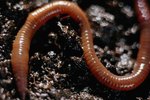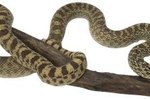
Moles are hairless, underground insectivores. Though they may resemble rodents, they're more closely related to shrews and bats. Seven mole species live in North America, with eastern moles (Scalopus aquaticus) being the most prevalent. Because they spend the vast majority of their time underground, only rarely venturing to the surface, they have few natural predators. There are other animals that also are skilled diggers and burrowers, however, and these are moles’ primary threats.
Mustelidae
The Mustelidae family includes species such as badgers and weasels that are known to prey on moles. These animals make up the largest family of carnivores, and many of them spend much of their lives underground. They are accomplished diggers that shelter and often hunt in underground burrows. Badgers and weasels share similar habitats and geographic distribution with moles, and small mammals make up much of their diet.
Mephitidae
The Mephitidae family consists of skunk and stink badger species previously considered mustelids, until biologists studied the animals further and concluded based on molecular evidence that they should be classified as a separate family. Several skunk species live in the same North American habitats as moles and frequently prey upon them. Although skunks are omnivorous, animals make up the majority of their diet. These nocturnal creatures spend their days in dug-out dens and their nights foraging and rooting through the soil to find food.
Canidae
Canids, including coyotes, foxes and domestic dogs, dig moles out of the ground and eat them. Although canids are more omnivorous than many species of carnivores, animals still make up the majority of their diet, particularly small mammals. Dogs and foxes are adept diggers with keen senses of smell that can detect a mole beneath the ground. Once they’ve found the mole, they bite the back of its neck and shake it, killing it by breaking its neck.
Birds of Prey
Although moles spend most of their lives in their underground tunnels, they do occasionally come to the surface – often by accident. When this happens, they risk falling victim to birds of prey flying overhead. Many raptor species, including vultures, hawks and eagles, live in the same areas as moles. The red-tailed hawk is one of the most common raptors in North America and can frequently be seen in the skies hunting for the small mammals that constitute the bulk of its diet. Moles that surface at night risk being killed and eaten by owls.
References
- Internet Center for Wildlife Damage Management: Moles
- University of Michigan Museum of Zoology: Animal Diversity Web: Mustelidae
- University of Michigan Museum of Zoology: Animal Diversity Web: Mephitidae
- University of Michigan Museum of Zoology: Animal Diversity Web: Canidae
- Raptor Research Foundation: Raptors of the World
Photo Credits
-
Photos.com/Photos.com/Getty Images
Writer Bio
Jennifer Mueller began writing and editing professionally in 1995, when she became sports editor of her university's newspaper while also writing a bi-monthly general interest column for an independent tourist publication. Mueller holds a Bachelor of Arts in political science from the University of North Carolina at Asheville and a Juris Doctor from Indiana University Maurer School of Law.




